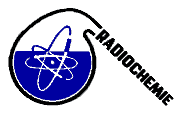Speaker
Dr
Kallola Kumar Swain
(BHABHA ATOMIC RESEARCH CENTRE, MUMBAI, INDIA)
Description
Many copper ores contain significant quantities of silver and gold. Copper concentrate, the intermediate in the ore processing, is an important source for production of gold and silver. Methods for determination of noble metals have been reviewed by Beamish and Van Loon [1]. The most common method for determination of noble metals in geological sample is atomic absorption spectrometry with a fire-assay pre-concentration step. One of the most sensitive method for analysis of noble elements is neutron activation analysis [2]. Instrumental neutron activation has been applied to determine of noble elements in ores, but generally it is required to separate noble elements from interfering and matrix activity. Several radiochemical schemes have been reported to isolate one or more of the noble metals during analysis. These schemes include solvent extraction, distillation, ion-exchange, precipitation and others.
Simultaneous determination of silver and gold in copper concentrate sample was carried out by neutron activation analysis method. Initially, copper concentrate sample was analysed by ED-XRF to obtain qualitative information and found that copper and iron were present in major proportions. Instrumental neutron activation analysis (INNA) was followed by radiochemical or chemical neutron activation analysis. During INAA, cooling time of about a week is required before 198Au could be measured because of high activity due to 64Cu and 24Na whereas 110mAg was measured after further cooling of a week. To reduce the analysis time, radiochemical neutron activation analysis and chemical neutron activation analysis were carried out. The noble elements form anionic complex with moderate molarity of HCl that are readily retained on anion exchanger. The distribution coefficient values for gold and silver are very high at lower HCl normality whereas copper and iron have negligible values. Sodium is not retained. Hence, ion exchange separation and pre-concentration of gold and silver were carried out from 1N HCl solution. The value of gold by INAA agreed well with the values obtained by RNAA and CNAA. However, the value for silver was significantly lower in case of RNAA and CNAA method compared to INAA. This may be due to loss of silver as silver chloride. The separation procedure was modified to avoid loss of silver during separation.
Reference
1. F. E. Beamish and J. C. Van Loon, “Recent advances in the analytical chemistry of the Noble metals”, Pergamon Press, Oxford, 1972.
2. Sanjiv Kumar, Rakesh Verma and S. Gangadharan, Analyst, 118 (1993) 1085.
Primary author
Mrs
Aditi A. Dalvi
(BHABHA ATOMIC RESEARCH CENTRE, MUMBAI, INDIA)
Co-authors
Dr
A V R Reddy
(BHABHA ATOMIC RESEARCH CENTRE, MUMBAI, INDIA)
Dr
Kallola Kumar Swain
(BHABHA ATOMIC RESEARCH CENTRE, MUMBAI, INDIA)
Mrs
Nicy Ajith
(BHABHA ATOMIC RESEARCH CENTRE, MUMBAI, INDIA)
Dr
Rakesh Verma
(BHABHA ATOMIC RESEARCH CENTRE, MUMBAI, INDIA)
Mrs
Remya Devi P S
(BHABHA ATOMIC RESEARCH CENTRE, MUMBAI, INDIA)

